Comments / Questions (38)
![]() Elly Finklenberg wrote:
Elly Finklenberg wrote:
In het patroon staat na 16 cm hoogte( kleinste maat ) meerderen voor mouwen, echter op tekening staat 26 cm
06.09.2025 - 16:40
![]() Louice wrote:
Louice wrote:
1. Har följt mönstret men upplever att ärmarna blir väldigt smala. Vad kan var fel? 2. Stickad söm med maskor - sömmen blir väldigt hård. Vad kan vara fel?
20.11.2022 - 15:25DROPS Design answered:
Hei Louice. 1) Genseren er rillestrikket = meget tøyelig. Men ta en titt på strikkefastheten som er oppgitt i oppskriften og se om du har den samme som er oppgitt. Se også på målskissen om du har de målene i den størrelsen du strikker. 2) Om maskestingene er strammet for hardt sammen kan de muligens bli litt harde. Det samme gjelder når man syr sammen innenfor 1 kantmaske ettersom det er flere lag som er blitt sydd sammen. mvh DROPS Design
21.11.2022 - 12:47
![]() Ruth wrote:
Ruth wrote:
Größe 1/3 Monate Beim Rückenteil steht in der Anleitung: ... nach 26 cm die äußersten 57 M. vom Ärmel gegen die Schulter abk. Sollten diese 57 M nicht wie beim Vorderteil auf eine Hilfsnadel gelegt werden und ich abgekettet? Am Schluss sollen doch die jeweils 57 M Vorderteil und Rückenteil der beiden Ärmel mit Maschenstich zusammengenäht werden. Hat sich da ein Fehler in der Anleitung eingeschlichen oder habe ich einen Denkfehler? Danke für ihre Antwort! Liebe Grüße
09.07.2022 - 21:28DROPS Design answered:
Liebe Ruth, ja stimmt, diese Maschen sollen Sie stilllegen, um die beiden Schulter separat zu stricken. Eine Korrektur erfolgt, danke für den Hinweis. Viel Spaß beim stricken!
11.07.2022 - 08:27
![]() Gina Deschenes wrote:
Gina Deschenes wrote:
Comment faire pour coudre le dessus des manches. ( Mailles laissées en attentees.)
08.01.2022 - 16:58DROPS Design answered:
Bonjour Mme Deschenes, assemblez-les en grafting, comme dans cette vidéo. Bonne continuation!
10.01.2022 - 08:09
![]() Ann wrote:
Ann wrote:
Hej, Funderar på följande... Nu sätts de yttersta 57-61-67 (80-91) m från nederst på ärmen och inåt mot axeln på 1 tråd. Maska av de resterande 16-17-18 (19-20) m. Vad ska man göra med dessa 57-61-67 (80-91) m sedan??
14.09.2021 - 10:02DROPS Design answered:
Hej Ann. De stickar du sedan ihop med maskorna från det andra stycket för att få en osynlig söm, i videon Osynlig söm - stickad ser du hur du ska göra. Mvh DROPS Design
17.09.2021 - 11:58
![]() Petra wrote:
Petra wrote:
Hallo ,ich habe eine Frage zu dem Sweet Ella Babypulli .Ich habe das Vorderteil soweit fertig gestrickt und am Ende steht die äußeren 57 Maschen vom Ärmel gegen die Schulter auf eine Hilfsnadel legen.Die restlichen 16 Maschen abketten.Jetzt weiss ich nicht was ich mit den 57 Maschen auf der Hilsnadel machen soll,auch abketten? Ich bitte um Hilfe.Danke!
15.07.2020 - 08:06DROPS Design answered:
Liebe Petra, die stillgelegten Maschen von den Ärmeln nähen Sie dann zusammen - siehe Technik im Video. Viel Spaß beim stricken!
15.07.2020 - 10:49
![]() Nora wrote:
Nora wrote:
Jag stickar för 6/9 månader. När arbetet mäter 27 cm är ärmen ca 3 cm bred längst ut. Vad missar jag?
13.05.2020 - 23:07DROPS Design answered:
Hej Nora, du starter udtagningerne når arb måler 17 cm, udtagningerne strikkes over 20 varv = ca 4,5 cm, det vil sige at du strikker over alle masker (også de yderste) fra 21,5 til 28 cm. God fornøjelse!
22.05.2020 - 09:12
![]() Ella wrote:
Ella wrote:
Hallo, Ich habe mit diversen Medien versucht das Diagramm zu öffnen, leider ist es für mich nicht sichtbar.. Könnten sie vielleicht prüfen, ob das Bild vielleicht nicht richtig hochgeladen ist? Das wäre toll, vielen Dank! Lg Ella
11.07.2019 - 17:07DROPS Design answered:
Liebe Ella, es gibt zu diesem Muster kein Diagram, aber Maßskizze wurde hochgeladen. Viel Spaß beim stricken!
06.08.2019 - 08:44
![]() Hilde Johansen wrote:
Hilde Johansen wrote:
Jeg kan ikke finne ut hva jeg skal gjøre med de maskene som er satt på tråd?
10.05.2019 - 12:38DROPS Design answered:
Hei Hilde. Du feller av de midterste maskene til hals, og setter maskene på den ene siden av avfellingen på en tråd. Så fortsteter du å strikke frem og tikbake over ermet og skulderen på den andre siden. Når du er ferdig, og har felt av setter du maskene på tråden tilbake på pinnen og strikker på samme måte. Altså du gjentar avsnittet fra "1.side: = 80-85-92 (106-118) m. Videre felles det til hals mot midt foran på hver 4.p slik: 2 m 2 ganger...." Maskene oppå ermet, som settes på en tråd når det felles av på skulderen skal monteres med maskesting. God fornøyelse
13.05.2019 - 15:20
![]() Bibi wrote:
Bibi wrote:
Hej! Jag har inte stickat så mycket och sitter nu med den tröja till mitt barnbarn. jag fattar inte hur det kan bli +190 m på arbetet efter man ökat för ärmarna, jag har följt mönstret men får då +130 m efter jag ökat för ärmarna? Stickar alltså storleken som är nr 3. Om det nu blir konstigt kan jag sticka ärmarna längre i efterhand?
03.04.2017 - 15:48DROPS Design answered:
Hei Bibi. Har du husket å øke til ermene på begge sidene? Du legger opp 71 masker til forstykket og når arbeidet måler 19 cm legger du opp nye masker i HVER side til ermene på hver 2.p (dvs på slutten av hver p): 3 masker 3 ganger = 9 masker i den ene siden + 9 masker i den annen siden (= 71+9+9= 89 masker). Deretter 4 masker 3 ganger (= 89+12+12= 113), så 10 masker 3 ganger (= 113+30+30= 173 masker). Og tilslutt 12 masker 1 gang (= 173+12-12=197). God fornøyelse!
04.04.2017 - 08:15
Sweet Ella#sweetellasweater |
|
 |
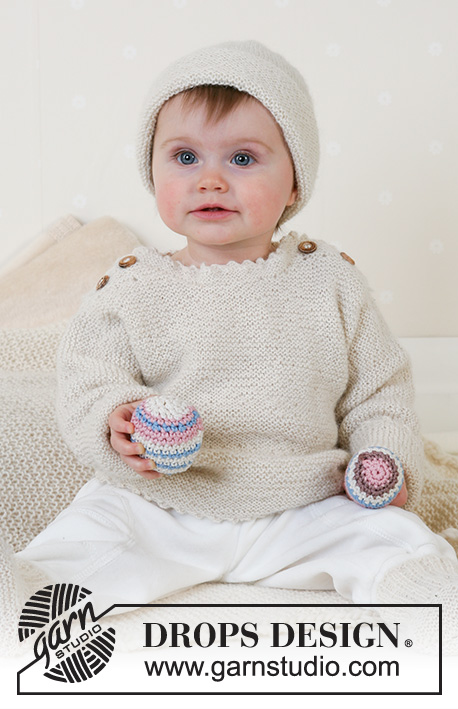 |
Knitted sweater with buttons and socks in DROPS Alpaca. Sizes baby and children from 1 month to 4 years.
DROPS Baby 14-13 |
|
|
JUMPER: Gauge: 24 sts x 48 in garter sts with Alpaca in garter sts on needle size 3 mm / US 2or3 = 10 x 10 cm / 4" x 4" Because of the number of sts, work back and forth on circular needle. Front piece: Cast on 58-64-71 (78-86) sts (includes 1 edge st each side) with Alpaca on circular needle size 3 mm / US 2or3 and knit garter sts. When piece measures 16-17-19 (20-22) cm / 6¼"-6¾"-7½" (8"-8¾") cast on new sts each side for sleeves at the end of every row, each side: 3 sts 3-3-3 (3-2) times, 4 sts 4-4-3 (5-8) times, 10 sts 2-2-3 (3-3) times and then 10-13-12 (15-14) sts 1 time = 168-180-197 (226-250) sts (includes 4 cm / 1½" fold-up on each sleeve). When piece measures 21-23-26 (27-30) cm / 8¼"-9"-10¼" (10⅝"-11¾"), bind off the middle 8-10-13 (14-14) sts for neck. Put sts on one side on a holder. 1st side: = 80-85-92 (106-118) sts. Now bind off for neck towards mid front on every 4th row as follows: 2 sts 2 times and 1 st 3 times = 73-78-85 (99-111) sts left on shoulder/sleeve. When piece measures 25-27-30 (32-35) cm / 9¾"-10⅝"-11¾" (12½"-13¾") bind off for 2 buttonholes on shoulder as follows from mid front: K2, K2 tog, yo, K7-8-9 (10-11) sts, K2 tog, yo, knit garter sts over remaining sts. Continue in garter sts until piece measures 26-28-31 (33-36) cm / 10¼"-11"-12¼" (13"-14¼"). Now put the outermost 57-61-67 (80-91) sts from sleeve edge and in towards the shoulder on a holder. Bind off the remaining 16-17-18 (19-20) sts. 2nd side: Put sts from first holder back on needle and work as 1st piece, but mirrored. Back piece: Cast on and work as front piece. Cast on new sts for sleeve as described for front piece and continue until piece measures 24-26-29 (31-34) cm / 9½"-10¼"-11⅜" (12¼"-13⅜") (do not make buttonholes on back piece). Now bind off the middle 18-20-23 (24-24) sts for neck and work each side separately. Then dec to shape the neckline on every other row: 1 st 2 times = 73-78-85 (99-111) sts left on shoulder/sleeve. When piece measures 26-28-31 (33-36) cm / 10¼"-11"-12¼" (13"-14¼") put the outermost 57-61-67 (80-91) sts from sleeve edge in towards the shoulder on a holder = 16-17-18 (19-20) sts left on shoulder. Continue in garter sts and bind off when piece measures 28-30-33 (35-38) cm / 11"-11¾"-13" (13¾"-15") (= button band). Repeat the other side of neck. Assembly: Sew upper sleeve seams (sts from holders) with neat sts. Sew side and under arm seams within 1 edge st. Neck: Pick up approx 30-40 sts from the right side along neckline on front piece with Alpaca and needle size 3 mm / US 2or3. Knit 6 rows garter sts and bind off from the wrong side. Repeat on back piece (also pick up sts along button edge). Sew on buttons. Crochet border: Using crochet hook size 3 mm / C or D, crochet a border round neck on front and back pieces, along bottom edge on front and back pieces and round sleeve edges as follows: 1 sc in 1st st, *3 ch, 1 hdc in the 1st of the 3 ch just crochet, 1 sc in each of the next 3 sts*, repeat from *-*. SOCKS: Size: 1/3 – 6/9 – 12/18 months (2 years) To fit foot length: 10-11-12 (14) cm / 4"-4½"-4¾" (5½") Rib: *K2, P2*, repeat from *-* The sock is worked back and forth from mid back. Cast on 48-52-56 (56) sts with 2 strands of Alpaca and needles size 2.5 mm / US 1or2. Remove 1 strand and work 5-6-6 (7) cm / 2"-2½"-2½" (2¾") in Rib – stop after a row from RS. K 1 row from the wrong side, at the same time dec 14-14-18 (14) sts evenly on row = 34-38-38 (42) sts. With row of eyelet holes: Work next row from the right side as follows: K1, *K2 tog, yo*, repeat from *-* and finish with K1. K1 row from wrong side. Without row of eyelet holes: K1 row from right side and K1 row from wrong side. Now put the outermost 12-13-13 (15) sts each side on a holder. Work 4-4.5-5.5 (6.5) cm / 1½"-1¾"-2¼" (2½") in garter sts over the middle 10-12-12 (12) sts. Put sts from holder back on needle and pick up 10-11-13 (16) sts on each side of middle piece = 54-60-64 (74) sts. Work 3-4-5 (5) cm / 1"-1½"-2" (2") in garter sts over all sts, at the same time after 1.5-2-2.5 (3) cm/½"-¾"-⅞" (1") start dec on every other row until finished measurements as follows: Dec 1 st at the beginning and at the end of row and K2 tog on each side of the 2 middle sts. Bind off when foot measures 10-11-12 (14) cm / 4"-4½"-4¾" (5½") and sew seam under foot and mid back. Pull a silk ribbon or similar through eyelet holes. HAT AND BLANKET: see pattern 14-12 BALL AND RATTLE: see pattern 13-32 |
|
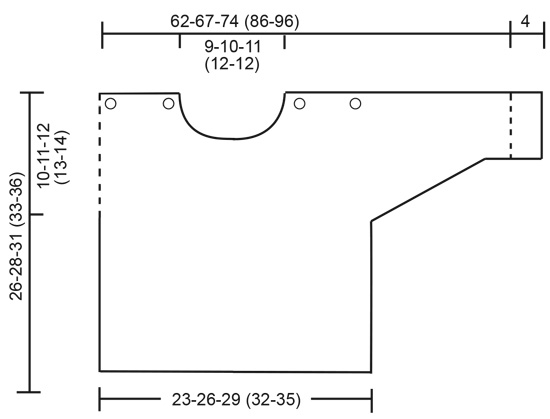 |
|
Have you finished this pattern?Tag your pictures with #dropspattern #sweetellasweater or submit them to the #dropsfan gallery. Do you need help with this pattern?You'll find 22 tutorial videos, a Comments/Questions area and more by visiting the pattern on garnstudio.com. © 1982-2025 DROPS Design A/S. We reserve all rights. This document, including all its sub-sections, has copyrights. Read more about what you can do with our patterns at the bottom of each pattern on our site. |
|








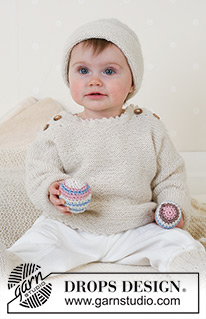

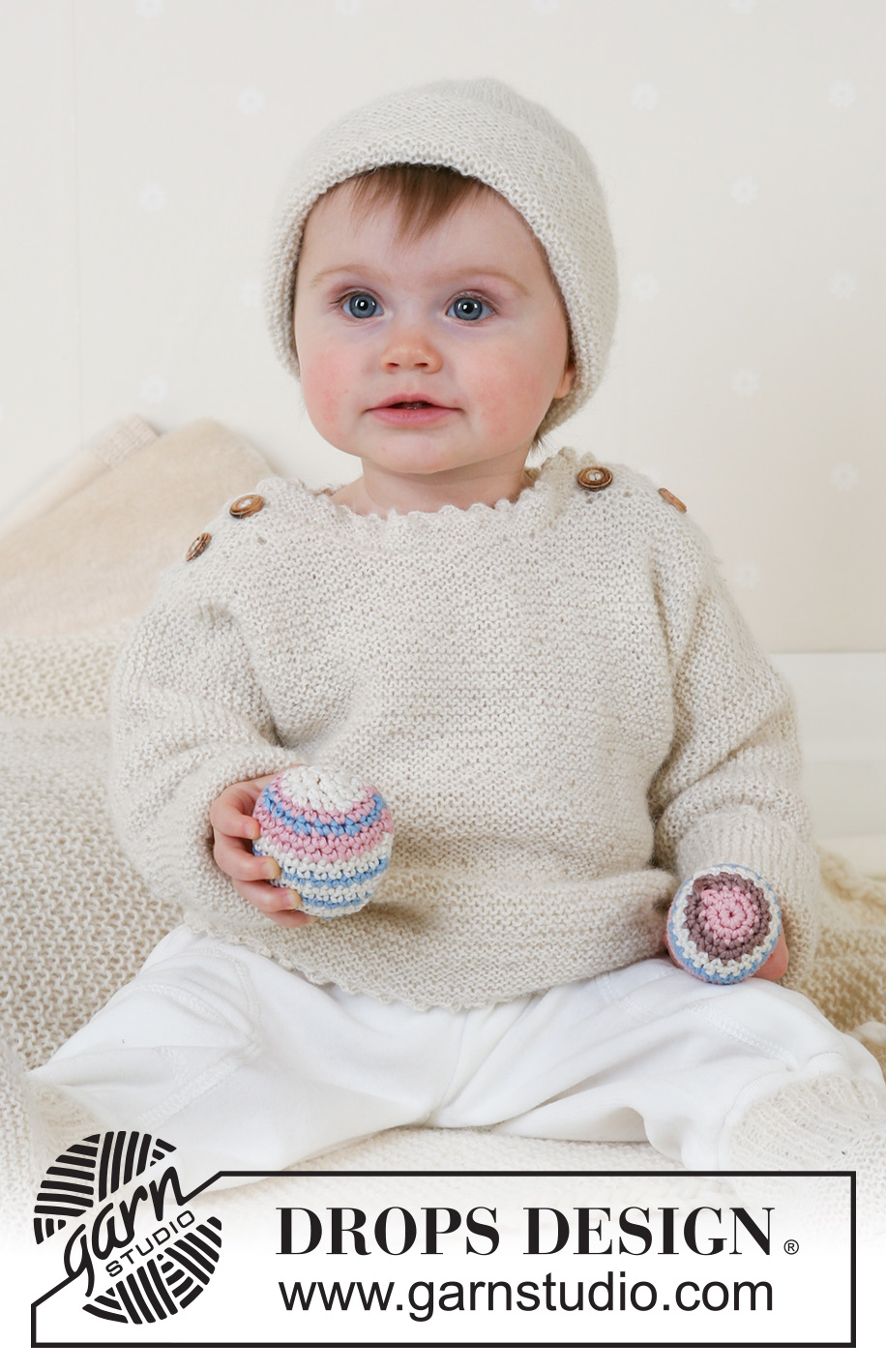

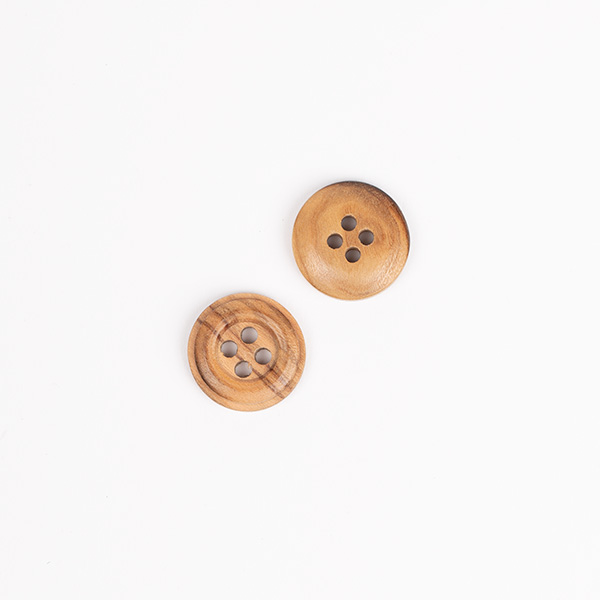















































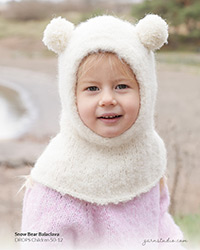
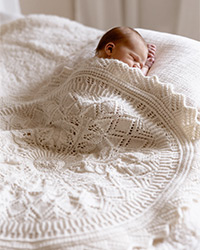
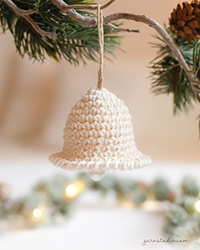
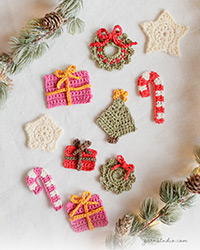
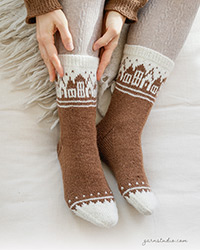
Post a comment to pattern DROPS Baby 14-13
We would love to hear what you have to say about this pattern!
If you want to leave a question, please make sure you select the correct category in the form below, to speed up the answering process. Required fields are marked *.